Time is one of the most valuable resources in today’s fast-paced world. If you want to ensure you always have enough, you need to learn how to manage it effectively.
Maybe you’ve heard of the time management matrix. But do you know the impact it can have on your productivity? It can make a big difference — if you know how to wield it.
This article will guide you through this useful tool, discussing what the four quadrants of the matrix mean and how you can use them to boost your productivity.
What is the time management matrix?
The time management matrix is a productivity tool developed by Stephen Covey in his book, The 7 Habits of Highly Effective People.
According to Covey, ranking tasks based on their importance and urgency can improve productivity and success. And this task prioritization is the heart of the matrix: it works by asking you to categorize tasks into four quadrants based on their urgency and importance.
By dividing tasks in this manner, you can identify the areas of your life that require instant attention and those that can be scheduled for a later date.
The theory behind the time management matrix
The theory behind the time management matrix is simple — not all tasks are created equal. Some are more pressing than others.
But the question remains, how do you determine whether a task is truly urgent?
The time management matrix builds on Dwight D. Eisenhower’s Decision Principle, emphasizing that urgency and importance are the only relevant factors when prioritizing tasks.
If a task doesn’t fall into Quadrant 1 or 2 (more on these below), it isn’t urgent enough to waste your time on.
Why is time management important?
Most high achievers will tell you that proper time management skills are the key to accomplishing their goals. When you stay focused on what matters, you can get more done.
Time management strategies can help simplify the process of organizing tasks, guiding you on what you should focus your time and energy on.
When you learn to better manage your time with the matrix, you have a lot to look forward to. The benefits of time management include the following:
- Increased productivity
- Reduced stress
- Improved decision-making
Why the time management matrix works better than a “to-do” list
The matrix works well because it’s based on human psychology and how our brains process information rather than an ideological approach.
A recent study showed that 46% of people experience a loss of control over their workload for one to two days a week, leading to anxiety and reduced productivity.
In contrast, to-do lists can be overwhelming and reduce self-confidence because you treat all your tasks equally.
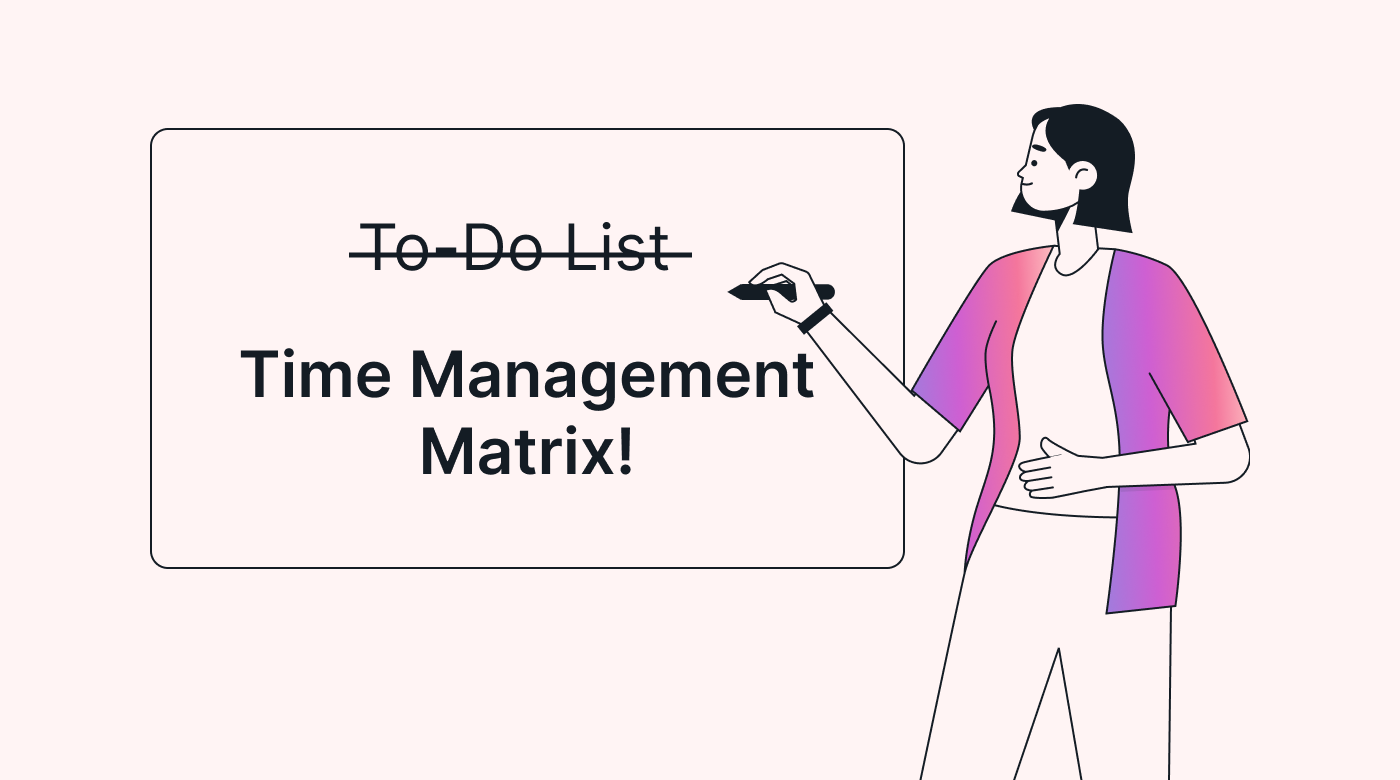 |
Motion recognizes the limitations of traditional to-do lists. Instead, it focuses on leveraging technology to help you complete critical tasks and meet your deadlines.
What are the 4 quadrants of the time management matrix?
You can use the four quadrants of the time management matrix to categorize tasks based on their urgency and importance — and in doing so, manage your time more effectively.
Here’s a breakdown of each quadrant:
Quadrant 1: urgent and important
This quadrant includes tasks that require immediate attention and are critical to achieving your goals. They’re often unexpected and can cause stress if not addressed promptly.
Examples include the following:
- Meeting a deadline for a major client
- Responding to an urgent email
- Dealing with a crisis
Quadrant 2: not urgent but important
These tasks are essential to your personal development but don’t require immediate attention. They can help prevent urgent tasks from arising in the future.
Examples include the following:
- Exercising regularly
- Building relationships with key stakeholders
- Developing a long-term business strategy
Quadrant 3: urgent but not important
This quadrant refers to jobs that require your attention but are not critical and distract you from completing more important tasks.
Examples include the following:
- Dealing with interruptions from family or friends
- Attending unnecessary meetings
- Answering unimportant emails
Quadrant 4: not urgent and not important
These are all the tasks you do during the day that are of low priority and don’t contribute to achieving your goals in any way.
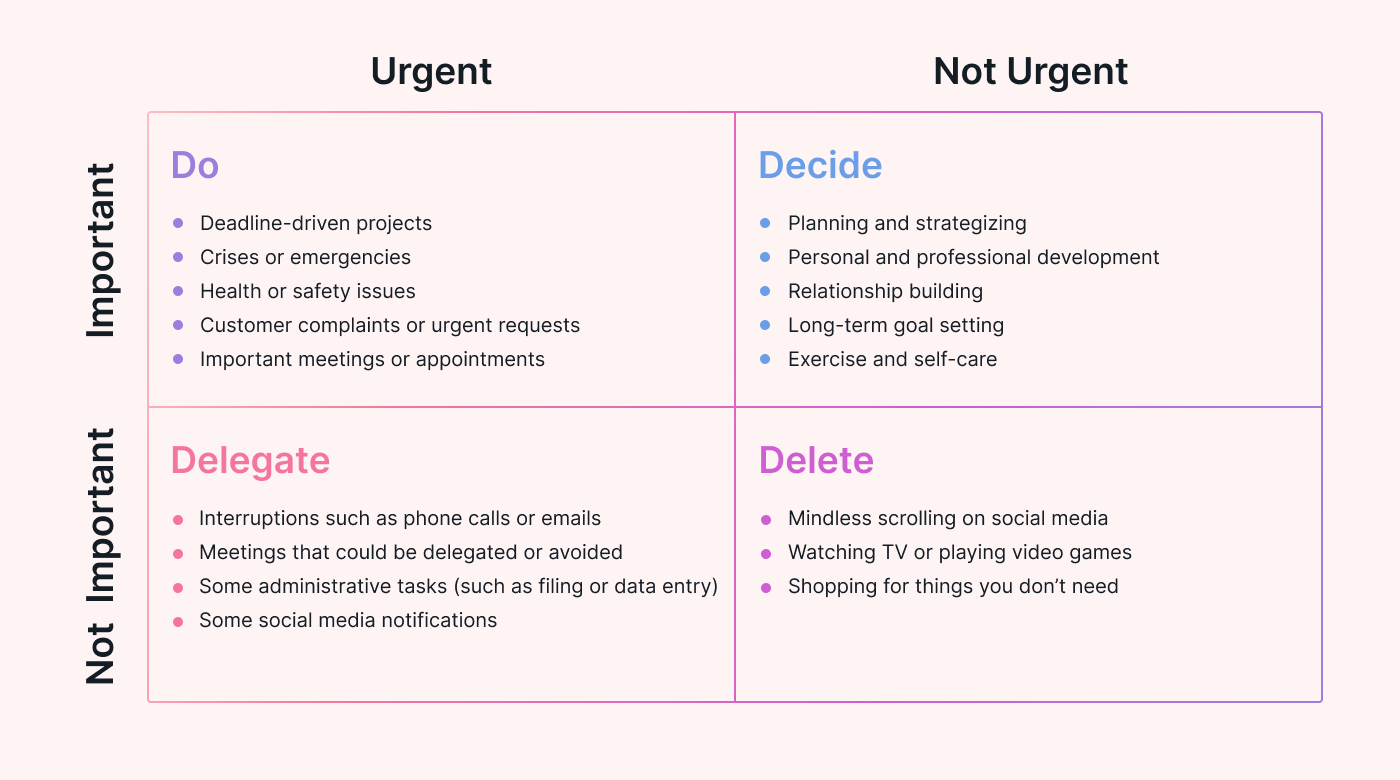 |
Examples include the following:
- Scrolling through social media
- Watching television
- Complaining about a coworker
How to use the time management matrix to boost your productivity
Stephen Covey’s time management matrix can help you prioritize tasks and minimize time-wasters.
Here’s a guide on how to use the matrix to boost your productivity:
1. Identify your tasks
Start by listing all the tasks you must complete within an allocated time. These can be work-related or personal.
Examples:
- Buying a gift for your mother
- Meeting a deadline
- Starting to exercise
2. Focus on Quadrant 2
Sort through your list of tasks, and highlight those that fall in Quadrant 2.
Be mindful of what tasks you select, as it can be tempting to prioritize tasks in Quadrant 1. However, remember that Quadrant 2 is your opportunity to focus on essential tasks that contribute to long-term goals.
Include things like this:
- Researching industry trends
- Learning a new skill to expand your knowledge base
Omit these:
- Checking your emails
- Organizing a party
3. Minimize time spent on Quadrant 4
To benefit from the matrix, focus on keeping Quadrant 4 tasks to a minimum.
A good hack is to try to complete an important task while enjoying a Quadrant 4 luxury. That way you can get something done even when you’re not doing anything. It’s the matrix’s productivity paradox — use it to your advantage.
Multitasking examples:
- Iron while watching Netflix
- Scroll through Instagram while out for a walk
4. Manage Quadrant 1
List your tasks from the most to least urgent, and complete them chronologically. This will help you focus on the most critical tasks first and avoid being overwhelmed by your workload.
Other management tips include the following:
- Avoiding procrastinating
- Setting strict deadlines
5. Delegate tasks
Avoid spending time on tasks that aren’t critical to your role and can be completed by another qualified person, like scheduling appointments or compiling data.
Delegating tasks is integral to time management, but it can be difficult to relinquish control.
Here are some tips that’ll help:
- Choose someone with the right skills and experience
- Provide clear instructions
- Offer support
6. Regularly update your priorities
A time management matrix isn’t a static document.
As your timetable changes, so too should your priorities. If you neglect to update your plan, you may find you’re no longer focusing on the most important task at hand.
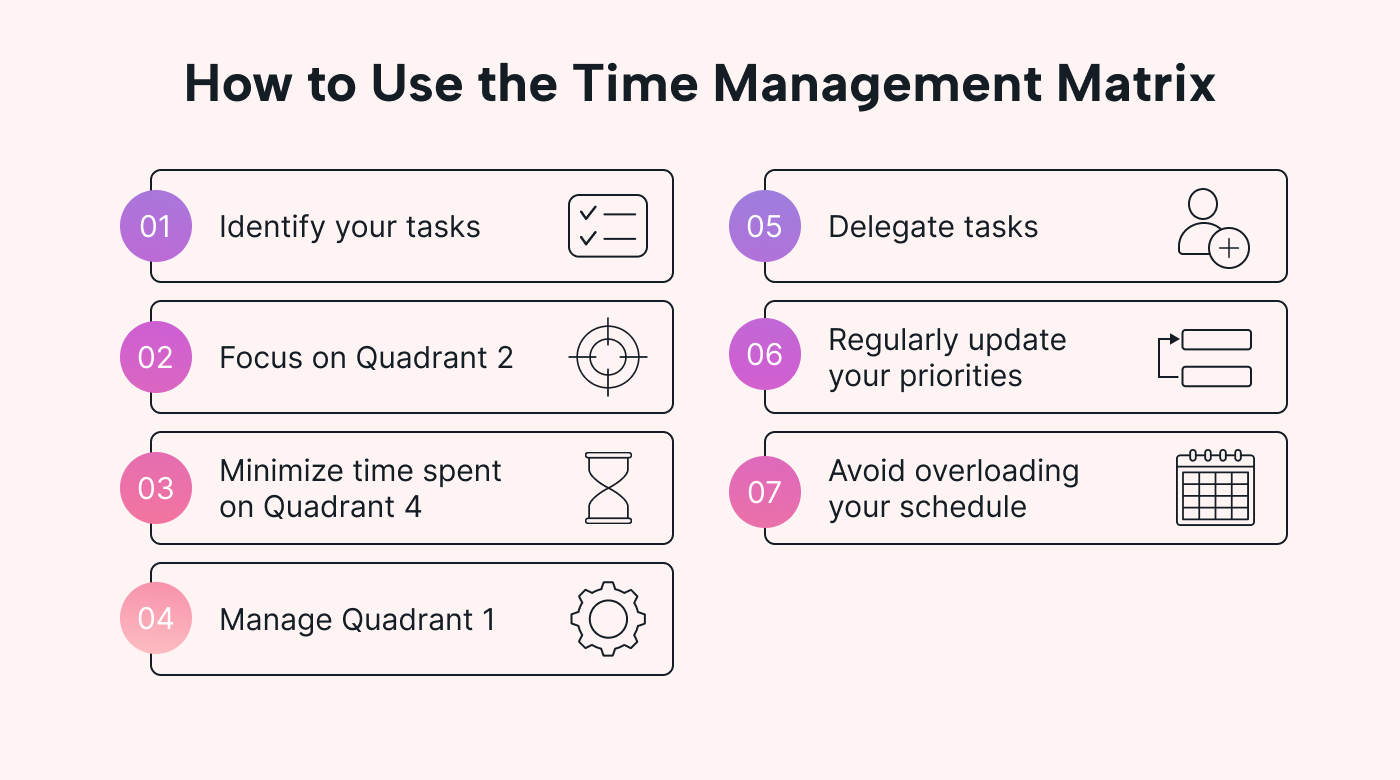 |
Here are some rules to follow:
- Be realistic about your workload
- Review your matrix at the beginning and end of each day
- Seek feedback from your colleagues or mentors
Time management matrix theory template
Use the template below as a guide or print it out and fill out the information.
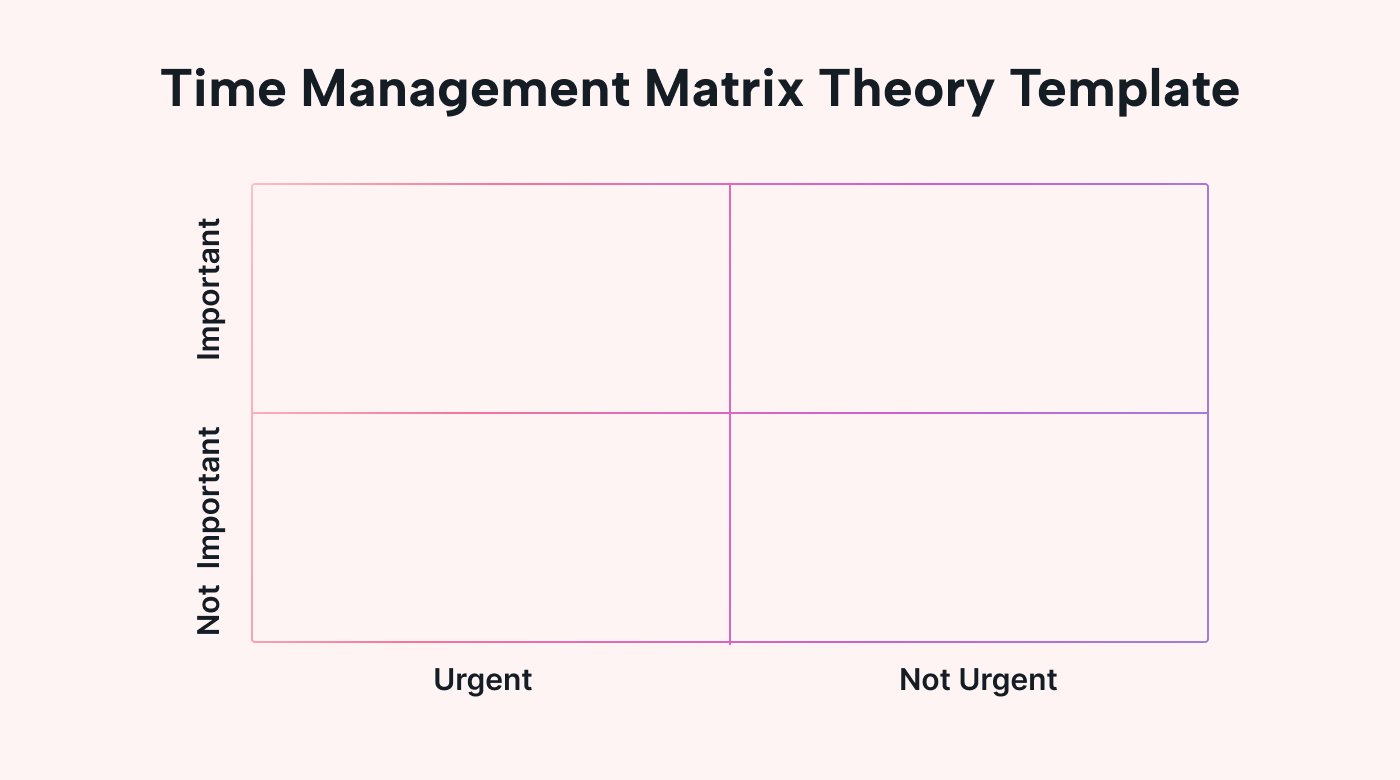 |
4 surprising benefits of the time management matrix
While one of the most significant impacts you’ll see when using the time management matrix is a boost in your daily productivity, there are also some other, perhaps surprising benefits. These include the following:
1. Increased creativity
Recent research has found that “…making time constraints ambiguous increased participants’ creativity.” What this shows is that when strict deadlines and time pressures don’t constrain individuals, they’re able to access their creative side.
The time management matrix increases creativity by:
- Reducing stress and mental clutter
- Fostering a sense of purpose and direction
- Helping you focus on getting things done instead of time you don’t have
2. Better decision-making
The time management matrix is a flexible tool that can be adapted to suit individual needs and preferences. That means, it can be used to make big or small decisions.
The time management matrix improves decision-making as follows:
- By providing a structured approach to tasks
- By reducing stress and anxiety
3. Improved relationships
When you identify what matters in the matrix, you’re going to list quality time with loved ones above social media scrolling or watching a movie. That will help you fit in time for family and friends, which can strengthen your relationships.
4. A greater sense of purpose
Identifying what makes you passionate about the work you’re doing can be incredibly powerful.
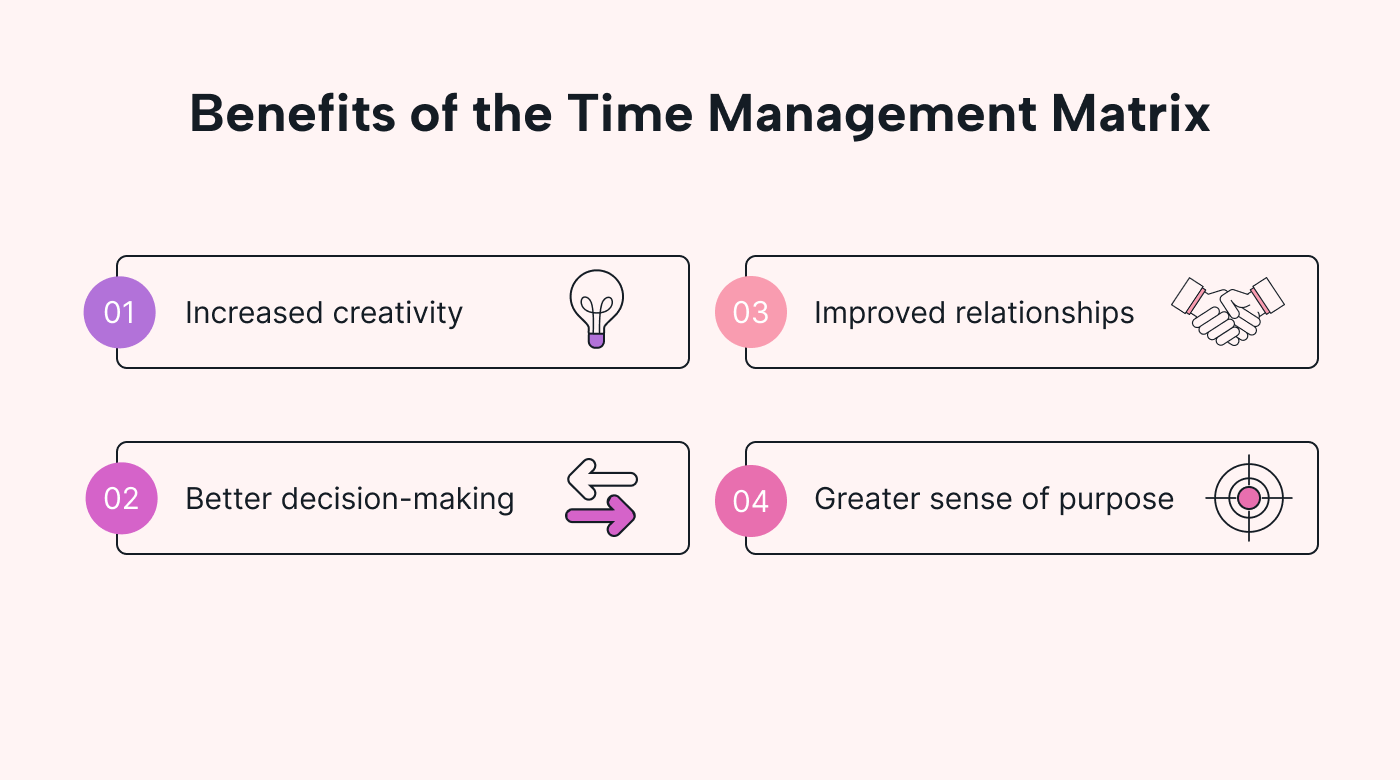 |
The time management matrix helps give you a greater sense of purpose as follows:
- By allowing you to do the work that matters most to you
- By helping you decide what’s important to your workflow
Common mistakes people make when using the matrix (& how to avoid them)
Now that you know the benefits of the time management matrix, it’s time to ensure you’re using it in the right manner.
Here’s a list of common mistakes people make and how to avoid them.
1. Not updating the matrix regularly
So many people make the mistake of assuming that what’s important and urgent today will be the same tomorrow.
But that’s not necessarily true. Life is constantly changing.
Without regular updates, the matrix is completely useless — like a to-list with no direction.
You can avoid this problem by:
- Reviewing Quadrant 1 and 2 tasks daily
- Removing irrelevant or completed tasks
- Being flexible when planning
2. Overloading Quadrant 2
As Quadrant 2 is all about planning and long-term investment, people often overload it with every goal they’ve ever wanted to achieve.
Unfortunately, this is a mistake. While focusing on self-improvement can be rewarding, it can create an imbalance in your life.
Here’s how to avoid this:
- Allocate a specific time in the day to completing Quadrant 2 tasks, and try not to exceed this time limit.
- Prioritize Quadrant 1 tasks above Quadrant 2 tasks in your schedule.
- Break down bigger tasks into daily habits — for instance, if you want to eat healthier, schedule a day for meal prep.
3. Confusing urgency with importance
When a task requires immediate attention and you feel stressed about getting it done, it can be challenging to determine its true importance.
That’s why people often fall into the trap of confusing “urgency” with “importance” and place tasks in Quadrant 1 that should really be in Quadrant 3.
For example, responding to random emails or phone calls may feel like an urgent task, but it could actually hinder your progress.
Here’s how to avoid this:
- Evaluate the weight of each task and consider its long-term impact.
- Clearly define the components of each task.
- Don’t be afraid to say “no.”
4. Not being flexible
Adhering strictly to the matrix can be a mistake.
People forget that while the matrix is impressive, it’s still only a tool designed to provide guidance and structure and can’t account for the unpredictability of life.
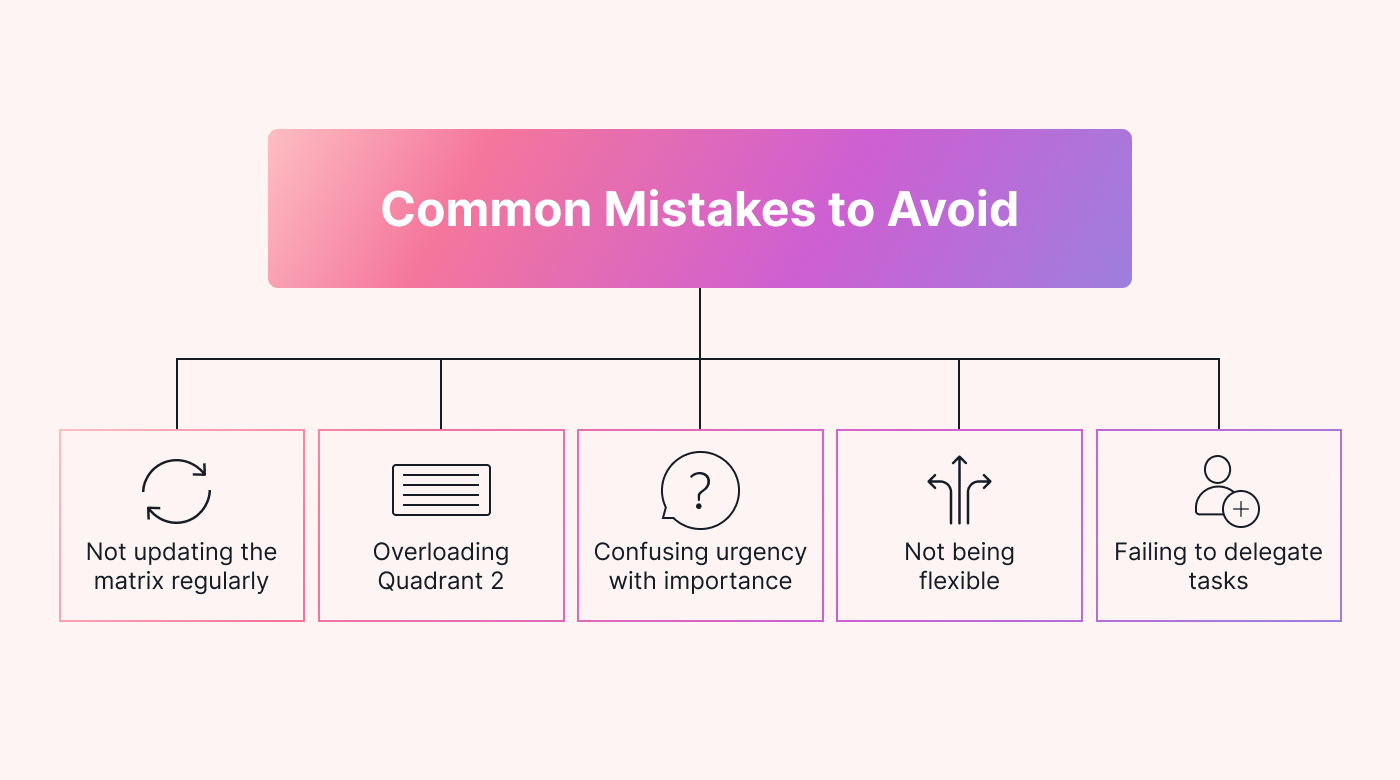 |
Here’s how to avoid this:
- Be willing to deviate from your plan to take advantage of new opportunities as they arise.
- Use the 80/20 rule — 80% of your time should be arranged based on tasks in the matrix, while 20% should be left free just in case something goes wrong or pops up.
Getting started with the time management matrix is easier than you think
You can begin using the time management matrix to manage your time more effectively and boost your productivity.
If you’re still confused by the process, investing in a task management tool like Motion that uses AI to intelligently plan your day, schedule meetings, and create a customized calendar based on task importance and urgency is a great option.
Motion is currently offering a 7-day free trial, so why not give it a try to see how it can transform the way you work?





